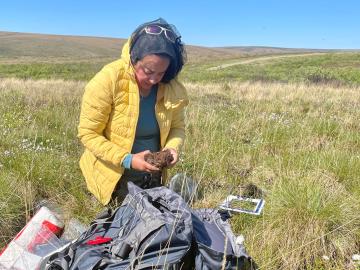
Filter News
Area of Research
- (-) Biology and Environment (69)
- (-) Materials (81)
- Advanced Manufacturing (24)
- Building Technologies (3)
- Computational Biology (1)
- Computational Engineering (3)
- Computer Science (15)
- Electricity and Smart Grid (3)
- Energy Science (178)
- Energy Sciences (1)
- Functional Materials for Energy (1)
- Fusion and Fission (10)
- Fusion Energy (3)
- Isotopes (1)
- Materials for Computing (19)
- Mathematics (1)
- National Security (29)
- Neutron Science (22)
- Nuclear Science and Technology (7)
- Quantum information Science (8)
- Sensors and Controls (1)
- Supercomputing (132)
News Topics
- (-) 3-D Printing/Advanced Manufacturing (27)
- (-) Big Data (11)
- (-) Computer Science (34)
- (-) Frontier (6)
- (-) Grid (8)
- (-) Microscopy (34)
- (-) Polymers (18)
- Advanced Reactors (4)
- Artificial Intelligence (15)
- Bioenergy (52)
- Biology (74)
- Biomedical (20)
- Biotechnology (14)
- Buildings (5)
- Chemical Sciences (36)
- Clean Water (14)
- Composites (11)
- Coronavirus (14)
- Critical Materials (13)
- Cybersecurity (5)
- Energy Storage (37)
- Environment (102)
- Exascale Computing (6)
- Fusion (8)
- High-Performance Computing (24)
- Hydropower (8)
- Irradiation (1)
- Isotopes (13)
- ITER (1)
- Machine Learning (12)
- Materials (78)
- Materials Science (82)
- Mathematics (4)
- Mercury (7)
- Molten Salt (3)
- Nanotechnology (42)
- National Security (5)
- Neutron Science (36)
- Nuclear Energy (16)
- Partnerships (13)
- Physics (29)
- Quantum Computing (3)
- Quantum Science (11)
- Security (3)
- Simulation (16)
- Space Exploration (2)
- Summit (11)
- Transportation (15)
Media Contacts

Madhavi Martin brings a physicist’s tools and perspective to biological and environmental research at the Department of Energy’s Oak Ridge National Laboratory, supporting advances in bioenergy, soil carbon storage and environmental monitoring, and even helping solve a murder mystery.

Wildfires are an ancient force shaping the environment, but they have grown in frequency, range and intensity in response to a changing climate. At ORNL, scientists are working on several fronts to better understand and predict these events and what they mean for the carbon cycle and biodiversity.

Wildfires have shaped the environment for millennia, but they are increasing in frequency, range and intensity in response to a hotter climate. The phenomenon is being incorporated into high-resolution simulations of the Earth’s climate by scientists at the Department of Energy’s Oak Ridge National Laboratory, with a mission to better understand and predict environmental change.

With the world’s first exascale supercomputer now fully open for scientific business, researchers can thank the early users who helped get the machine up to speed.

Oak Ridge National Laboratory researchers recently demonstrated use of a laser-based analytical method to accelerate understanding of critical plant and soil properties that affect bioenergy plant growth and soil carbon storage.

Scientist-inventors from ORNL will present seven new technologies during the Technology Innovation Showcase on Friday, July 14, from 8 a.m.–4 p.m. at the Joint Institute for Computational Sciences on ORNL’s campus.

Rigoberto Advincula, a renowned scientist at ORNL and professor of Chemical and Biomolecular Engineering at the University of Tennessee, has won the Netzsch North American Thermal Analysis Society Fellows Award for 2023.

Nature-based solutions are an effective tool to combat climate change triggered by rising carbon emissions, whether it’s by clearing the skies with bio-based aviation fuels or boosting natural carbon sinks.

Tomonori Saito, a distinguished innovator in the field of polymer science and senior R&D staff member at ORNL, was honored on May 11 in Columbus, Ohio, at Battelle’s Celebration of Solvers.
Oak Ridge National Laboratory scientists led the development of a supply chain model revealing the optimal places to site farms, biorefineries, pipelines and other infrastructure for sustainable aviation fuel production.


